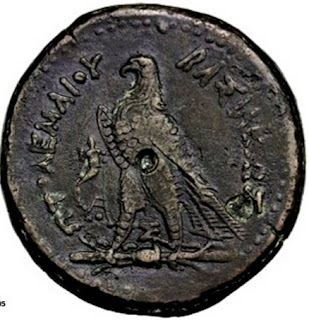Vajra (In Sanskrit means thunderbolt and diamond), in Hindu mythology is a powerful weapon of the thunder deity Indra, the Vedic god of war and king of the devas. It is considered as one of the most powerful weapons in the universe in Hindu mythology. The use of vajra as a symbolic and ritual tool spread to other religions in India and other parts of the world.
Seleucia, Persia coin, 2nd century BC, winged thunderboltVajra
The fiercest weapon, was made for Indra by the bones of the spine of the Sage Dadhichi, (who voluntarily sacrificed his body), to kill an asura named Vritra, who was the recipient of a boon whereby he could not been killed by any weapon known till then.
The earliest mention of the vajra is in the Rigveda, part of the four Vedas. Many later Puranas too describe the vajra. The vajra is a type of club with a ribbed spherical head. The ribs may meet in a ball-shaped top, or they may be separate and end in sharp points. It may have three, five or nine prongs
Vajra with open prongs
Buddhist legend suggests that the Buddha himself took the vajra and closed its prongs, thus transforming it from a destructive weapon to a peaceful scepter. In Buddhism, the vajra is a symbol of Vajrayana, one of the three major schools of Buddhism. Vajrayana is translated as ''Thunderbolt Way'' or ''Diamond Way'' and can imply the thunderbolt experience of Bodhi or enlightenment and indestructibility. Like the diamond, the vajra destroys but is itself indestructible and is thus linked to sunya (all-inclusive void)
The Thunderbolt and bell or the vajra (in Tibetan also called Dorjie) and bell (in Tibetan called drilbu) are the most important ritual objects of Tibetan Buddhism. Every Lama has a pair . They represent ''method'' and ''wisdom''. Combined they symbolize enlightenment
Vajra and Bell
Buddhist Symbolism. The Vajra is made up of several parts. In the center is a sphere which represents Sunyata, the primordial nature of the universe. Emerging from the sphere are two eight petaled lotus flowers. One represents the phenomenal world (Samsara), the other the noumenal world (Nirvana). Arranged equally around the mouth of the lotus are two, four or eight creatures called ''makara''. These are mythological half fish, half crocodile creatures. The five pronged vajra is most common, each prong representing a wisdom.
Vajra in the hand of Buddha
The symbol of ''thunderbolt'' as a tool of destruction is found in many ancient civilizations, and mythology always associates lightening with a sky god, who uses it as a weapon.
In ancient Greek mythology, it is associated with the Greek god Zeus (thunder god who ruled as kings of gods). The thunderbolt is a weapon given to Zeus by the Cyclopes.
Statue of God Zeus wearing a himation and holding a thunderbolt
Based on this, in Roman mythology, the thunderbolt is a weapon given to Jupitar (god of the sky and thunder in Roman mythology) by the Cyclopes, and is thus one of the emblems of Jupitar, often depicted on Greek and Roman coins and elsewhere as an eagle holding it in its claws, a thunderbolt which resembles in form a bundle of crossed sticks.
Ptolemy IV, Philopatry 221-205 BC coin, Eagle on thunderbolt between legs
In Sumerian cosmology, its use is recorded in the Babylonian Epic of Creation, the Enuma Elish. A battle between sky god Marduk and the evil and powerful Tiamat is depicted on the fourth tablet of this ancient document. Images show Marduk holding a three tipped scepter.
In Hittite (and Hurrian) mythology (1650 BC-1178 BC), a triple thunderbolt was one symbol of Teshub (Tarhunt)
In Celtic mythology (1200 BC-500 BC), Taranis is the god of thunder
In Norse mythology or Scandinavian mythology , Thor is specifically the god of thunder and lightening, wielding Mjolnir. His mighty hammer Mjolnir was the most fearsome weapon that would never fail
In Finnish mythology, Ukko is the god of thunder, wielding Ukonvasara
In Slavic mythology, Perun is the god of sky, controlling thunder and lightening and wields the Axe of Perun. It would return to his hand after it was thrown.
Irish mythology had a similar weapon known as the Gae Bolga or lightening spear or dart. The Irish bookof Leinster describes the devastating effects of the Gae Bolga.
In Turkish mythology, Bayulgen creates thunderbolts
In Maya mythology, Huracan is represented as three thunderbolts
In Gurani, Cherokee and Ojibway mythologies, Tupa, An Hyuntikwalaski and Thunderbirds are all the embodiments of thunder and lightening powers
In Igbo and Yoruba mythologies, the thunderbolt is a powerful weapon.
In China, the legend of Hua-hu Tiao Devours Yang Chien describes a magical spike carried by Huang Tien Hua which sounds remarkably similar to Indra's Vajra
Vajra is used as a symbol and as a weapon in Nepal, Bhutan, Tibet and Thailand.
Param Vir Chakra, India's highest war time gallantry award has a motif of Vajra.
Param Vir Chakra, with a motif of Vajra
The Vajra, or thunder producing weapon shows the commonality around the world in legend, mythology, iconography and symbolism. The universality of this symbol shows that such weapons existed in ancient times and were documented. Weapons that emitted thunder.
Coins with Vajra / Thunderbolt symbol
Panchalas of Ahichhatra, 75-50 BC, Indramitra, weight 5.9 g, with Indra holding Vajra/thunderbolt
Sicily, Syracuse, Zeus and thunderbolt/vajra, 357-354 BC,



























No comments:
Post a Comment
Any inputs or feedback is welcome!